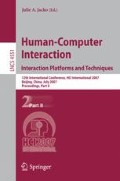Abstract
We present the approach and prototype of a system that supports the acquisition of bilingual knowledge. In this paper we focus on the domain of vocabulary acquisition for Chinese. Mapping visualizations, especially Bilingual Knowledge Maps [1], can be used to foster acquisition of word knowledge, dictionary navigation, and testing. We developed style sheets that map between knowledge representation and visualization tailored for Chinese- English bilingual data. This is on the one hand used to generate maps that visualize knowledge in a pedagogically reasonable way. On the other hand, user input and knowledge base can be queried. This more sophisticated functionality is enabled by using Semantic Web techniques. These techniques further allow us to integrate different (possibly distributed) data sources that contain relevant relationships.
Access this chapter
Tax calculation will be finalised at checkout
Purchases are for personal use only
Preview
Unable to display preview. Download preview PDF.
References
Bahr, G.S., Dansereau, D.F.: Bilingual Knowledge Maps (BiK-Maps) in second-language vocabulary learning. The Journal of Experimental Education 70(1), 5–24 (2001)
Tergan, S.-O., Keller, T. (eds.): Knowledge and Information Visualization. LNCS, vol. 3426. Springer, Heidelberg (2005)
Novak, J.D., Gowin, D.B.: Learning how to learn. Cambridge University Press, Cambridge (1984)
Buzan, T., Buzan, B.: The Mind Map book. BBC Books, London (1993)
Dansereau, D.: The development of a learning strategy curriculum. In: O’Neill, H. (ed.) Learning Strategies, pp. 1–29. Academic Press, New York (1978)
Geroimenko, V., Chen, C.: Visualizing the semantic Web. Springer, London (2002)
Novak, J.D., Canas, A.J.C.: The origins of the concept mapping tool and the continuing evolution of the tool. 5, 175–184 (2006)
Aliprand, J., Consortium, U.: Unicode4 The Unicode standard: version 4.0. Addison-Wesley, Reading (2003)
Berners-Lee, T., Hendler, J., Lassila, O.: The semanticweb. Scientific American 284, 34–43 (2001)
Fellbaum, C.: WordNet: an electronic lexical database. Language, speech, and communication. MIT Press, Cambridge, Mass (1998)
Manning, C.D., Jansz, K., Indurkhya, N.: Kirrkirr: Software for browsing and visual exploration of a structured warlpiri dictionary. Literary and Linguistic Computing 16(1), 123–139 (2001)
Jing-Schmidt, Z.: Cognitive foundations of the Chinese writing system and their pedagogical implications. In: Poerner, M. (ed.) ???? Hanz1 renzhi - How Western Learners Discover the World of Written Chinese, Germersheim. Fachbereich Angewandte Sprach- und Kulturwissenschaft der Universität Mainz (2005)
Dong, Z., Dong, Q.: Hownet And the Computation of Meaning. World Scientific Publishing Co. Inc, River Edge, NJ, USA (2006)
DeFrancis, J.: Visible speech: the diverse oneness of writing systems. University of Hawaii Press, Honolulu (1989)
Aliprand, J., the Unicode Consortium.: The Unicode standard: version 4.0. Addison-Wesley, Boston (2003)
Bahr, G.S., Dansereau, D.F.: Bilingual Knowledge (BiK-) Maps: Study strategy effects. In: Cañas, A.J., Novak, J.D., González, F.M. (eds.) Proceedings of the First International Conference on Concept Mapping (CMC 2004). Pamplona, Spain, NovaText, vol. 1, pp. 59–66 (2004)
Bahr, G.S., Dansereau, D.F.: Bilingual knowledge maps (bik maps) as a presentation format: Delayed recall and training effects. The Journal of Experimental Education 73(2), 101–118 (2005)
Cañas, A.J., Coffey, J.W., Carnot, M.J., Feltovich, P., Hoffman, R.R., Feltovich, J., Novak, J.D.: A summary of literature pertaining to the use of concept mapping techniques and technologies for education and performance support. Technical report, Institute for Human and Machine Cognition (2003)
Paivio, A., Desrochers, A.: A dual-coding approach to bilingual memory. Canadian Journal of Psychology 34, 388–399 (1980)
Wallace, D.S., West, S.W.C., Ware, A., Dansereau, D.F.: The effect of knowledge maps that incorporate gestalt principles on learning. Journal of Experimental Education 67, 5–16 (1998)
Ware, C., Purchase, H., Colpoys, L., McGill, M.: Cognitive measurements of graph aesthetics. Information Visualization 1(2), 103–110 (2002)
Author information
Authors and Affiliations
Editor information
Rights and permissions
Copyright information
© 2007 Springer-Verlag Berlin Heidelberg
About this paper
Cite this paper
Wissmann, J., Bahr, G.S. (2007). Bilingual Mapping Visualizations as Tools for Chinese Language Acquisition. In: Jacko, J.A. (eds) Human-Computer Interaction. Interaction Platforms and Techniques. HCI 2007. Lecture Notes in Computer Science, vol 4551. Springer, Berlin, Heidelberg. https://doi.org/10.1007/978-3-540-73107-8_19
Download citation
DOI: https://doi.org/10.1007/978-3-540-73107-8_19
Publisher Name: Springer, Berlin, Heidelberg
Print ISBN: 978-3-540-73106-1
Online ISBN: 978-3-540-73107-8
eBook Packages: Computer ScienceComputer Science (R0)

